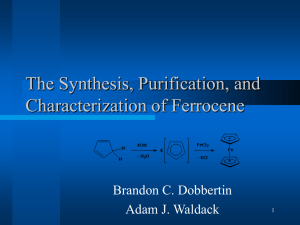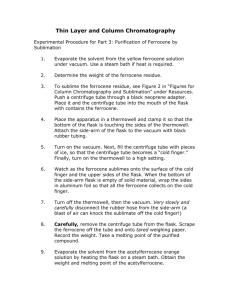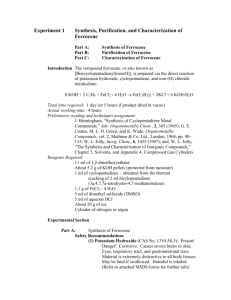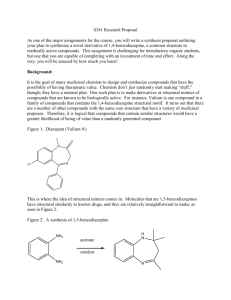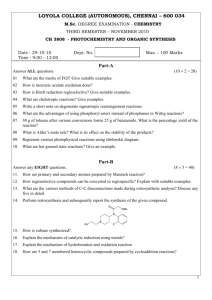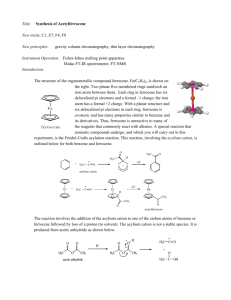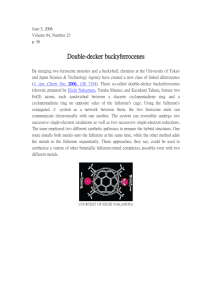ANNUAL REPORT (June 16, 2005 to June 16, 2006) Title: Synthesis
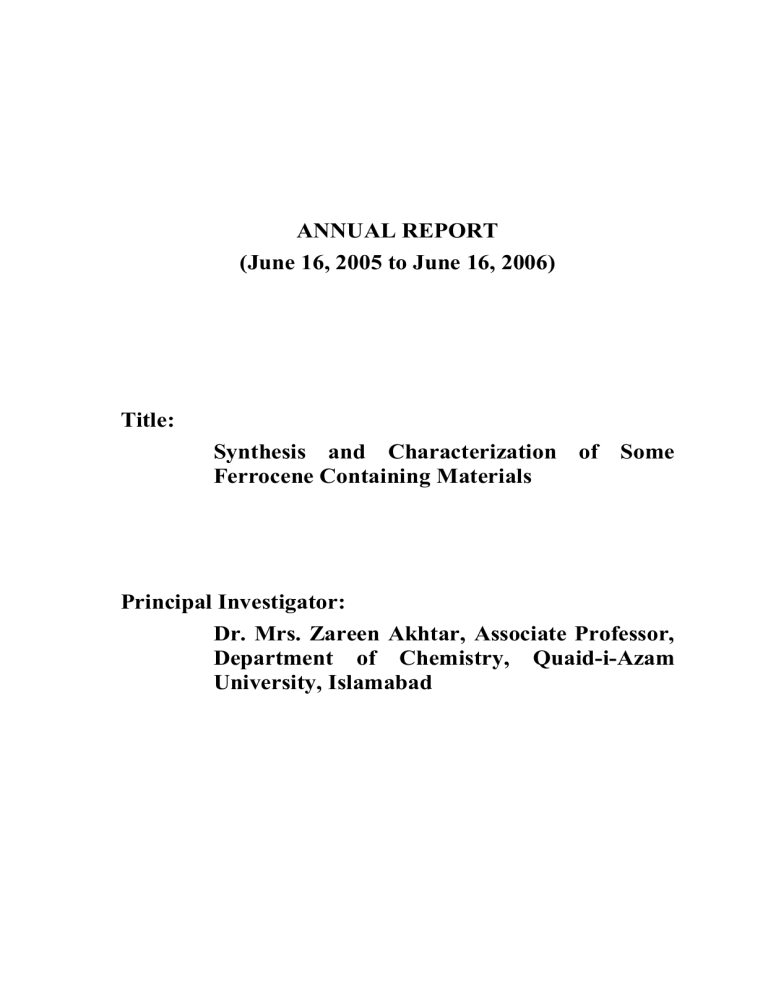
ANNUAL REPORT
(June 16, 2005 to June 16, 2006)
Title:
Synthesis and Characterization of Some
Ferrocene Containing Materials
Principal Investigator:
Dr. Mrs. Zareen Akhtar, Associate Professor,
Department of Chemistry, Quaid-i-Azam
University, Islamabad
1. Title: Synthesis and Characterization of Some Ferrocene
Containing Materials
2. Duration and Status: 2005-2006
3. Achievements of the Project this Year
3.1 Abstract
Some new ferrocenomesogens were synthesized by condensation of 4-ferrocenylaniline with p-alkoxybenzoyl chloride of different alkylhalides. 4-Ferrocenylaniline was prepared by a reported method and p-alkoxybenzoyl chlorides were synthesized by condensation of p-hydroxyethyl benzoate with alkylhalides of different carbon chain length, followed by the hydrolysis of the esters to the corresponding p-alkoxybenzoic acid and purified by recrystallization. The synthesized acids were then converted to their respective acid chlorides and condensed with 4-ferrocenylaniline to get 4-alkoxy-N-(4ferrocenylphenyl)benzamides. Similarly, the organic analogues of the ferrocenyl benzamides were prepared for comparison by the condensation of acid chlorides with aniline. The resulting liquid crystalline materials were characterized by their elemental analyses, physical properties and FT-IR and NMR spectral studies. The liquid crystalline behaviour of the synthesized materials was confirmed by differential scanning calorimetry and hot stage optical polarizing microscopy.
3.2 Introduction
The difference between crystals and liquids, the two most common condensed matter phases, is that the molecules in a crystal, are ordered whereas in a liquid they are not. The order in a crystal is usually both positional and orientational, is that the molecules are constrained both to occupy specific sites in a lattice and to point their molecular axes in specific directions. The molecules in liquids, on the other hand, diffuse randomly throughout the sample container with the molecular axes tumbling widely.
Interestingly enough, many phases with more order than present in liquids but less order than typical of crystals also exist in nature. These phases are groped together and called liquid crystals, since they share properties normally associated with both liquids and crystals.
1
Metallomesogens are the liquid crystalline complexes in which the metal atom is coordinated by a covalently bound organic ligand via either a carbon atom or a
-system.
Both monodentate (phenyl, alkynyl, isonitrile) and bidentate azo, imine, azine and azoxy ligands can be C-coordinated to a metal. Furthermore, bidentate ligands can give rise to two different kinds of compounds: dinuclear and mononuclear orthometallated compounds. As far as
-coordinated complexes are concerned, the largest groups consist of liquid crystal derived from metallocenes.
Ferrocene is one of the metallocene which is useful for formation of ferrocenomesogens. The ferrocenyl unit is not only useful for modifying the shape of a molecule; in addition the metal atom with its large electron density can be used to modify the physical properties such as color, polarizability and magnetism
[1]
.
Recently, ferrocene has been widespread studied in the field of liquid crystalline materials
[2]
. One important reason for this is that the methods for the synthesis of ferrocene derivatives offer ample opportunities for structure variations. Deschenaux
[3-6] reported the first example of electron-transfer induced mesomorphism in the ferroceneferrocenium redox system, fullerene-ferrocene mixed liquid-crystalline materials and polymethacrylate thermotropic liquid crystal of ferrocene-containing side chain.
Ferrocene is a three-dimensional bulky unit, so that, regardless of the substituent’s nature, this unit could cause steric repulsion with neighbouring molecules.
These interactions could lead to a decrease of the transition temperature domain
[7]
.
There are different kinds of ferrocenomesogens according to their substitution.
1.
2.
3.
Monosubstituted ferrocenomesogens
1,1
-Disubstituted ferrocenomesogens
1,3-Disubstituted ferrocenomesogens
3.2.1 Monosubstituted ferrocenomesogens
Monosubstituted ferrocene derivatives contain the ferrocenyl unit as a terminal group
[8]
. The incorporation of a ferrocenyl group in the terminal position in an elongated molecule results in a monomolecular L-shape geometry. In such cases the bulky ferrocenyl unit is expected to lead to repulsive steric effects, which would have an adverse effect on the intermolecular interactions. A possible way of minimizing the unfavourable seric effects would be to lengthen the mesogenic unit (MU) in order to improve the length: width ratio of the molecule
[9]
.
2
3.2.2 1,1
-Disubstituted ferrocenomesogens
These mesogens exist in the fully extended S-shaped geometry where the ferrocene unit introduces a ‘step’ into the structure.
3.2.3 1,3-Disubstituted ferrocenomesogens
In these type of mesogens the ferrocenyl unit is in center of two mesogenic unit and it shows T-shaped structure.
3.3 Experimental
3.3.1 Chemical Reagents
All chemical reagents used for the synthesis were of highest purity or otherwise mentioned. Ferrocene, Thionyl chloride (SOCl
2
), hydrochloric acid, hexadecyltrimethyl ammonium bromide, p-nitroaniline, hydrazine, sodium nitrite, aniline, 1-bromobutane, 1bromohexane, 1-bromononane, 1-bromododecane, 1-bromooctadecane, pyridine and triethylamine were obtained from Fluka (Germany). 4-Hydroxybenzoic acid was obtained from Aldrich. Absolute ethanol, hexane, diethyl ether, acetone, chloroform, dimethylsulfoxide, dichloromethane and ethyl acetate were obtained from E. Merk.
Tetrahydrofuran (THF) was obtained from Riedel-de-Haën (Germany).
All of these solvents were freshly distilled and dried as per requirement. Liquid crystals were synthesized under atmosphere created by using vacuum line and dry N
2 gas. The reactions for synthesis of liquid crystals and purity of product was monitored by thin layer chromatography using pre-coated Kieselgel 60-HF
250
TLC plates using the eluent system that gave the best separation.
3.3.2 Analytical Techniques and Instrumentation
Melting temperatures of the liquid crystals were determined on melting point apparatus, Mel-Temp, Mitamura Riken Kogyo, Inc. Tokyo, Japan, using sealed capillary method.
The solid state Fourier transfer infrared spectra (KB pellets, 4000-400 cm recorded on Biorad Excalibur FT-IR Model FTS 3000 MX.
–1
) were
1
H NMR and
300 MHz instrument.
13
C NMR spectral analyses were carried out by using Ultra Shield
C, H, N analysis was also done.
3
Polarized optical microscopy and differential scanning calorimetry analysis results are awaited.
3.3.3 Synthetic Methodology
1) Synthesis of 4-Ferrocenylaniline
NH
2
Fe
Cl N
2
-Ph-NO
2
PTC, Et
2
O
Fe
NO
2
EtOH
Pd-C, Hydrazine
Fe
Scheme-1
2) Synthesis of p-Alkoxy-N-(2-ferrocenylphenyl)benzamides (Ua1-5) [10]
HO
RO
I
RO
V ( 1-5 )
COOH
+ C
2
H
5
OH
Conc. H
2
SO
4
HO
O
C OH
IV ( 1-5 )
SOCl
2
5 hrs reflux
O
C Cl
+ Fe
0.5M KOH in 5% H
2
O
12 hrs reflux
RO
NH
2
III ( 1-5 )
COOC
2
H
5
+ R-Br
( 1-5 )
II i) K
2
CO
3
anhydrous ii) Dry acetone + 10% dry DMSO iii) N
2
48 hrs reflux
O
COOC
2
H
5
IV
Fe
Dry THF
Et
3
N
0 o
C-Room temp.
Inert atmosphere
N
H
O
C
Ua ( 1-5 )
OR
R = 1 ) CH
3
CH
2
CH
2
CH
2
-
2 ) CH
3
(CH
2
)
4
CH
2
-
3 ) CH
3
(CH
2
)
10
CH
2
-
4 ) CH
3
(CH
2
)
8
-
5 ) CH
3
(CH
2
)
17
-
4
Scheme-2: Synthesis of p-Alkoxy-N-(2-ferrocenylphenyl)benzamides (Ua1-5) [10]
3) Synthesis of p-Alkoxy benzamides (Ub1-5)
HO
RO
I
COOH
+ C
2
H
5
OH
Conc. H
2
SO
4
HO
COOC
2
H
5
+ R-Br
( 1-5 )
II i) K
2
CO
3
anhydrous ii) Dry acetone + 10% dry DMSO iii) N
2
48 hrs reflux
COOC
2
H
5
0.5M KOH in EtOH
+
5% H
2
O
12 hrs reflux
RO
IV ( 1-5 )
SOCl
2
5 hrs reflux
NH
2
COCl
III ( 1-5 )
COOC
2
H
5
IV
+
RO
V ( 1-5 )
Dry THF
Et
3
N
0 o
C-Room temp.
Inert atmosphere
N
O
C
H
Ub ( 1-5 )
OR
R = 1 ) CH
3
CH
2
CH
2
CH
2
-
2 ) CH
3
(CH
2
)
4
CH
2
-
3 ) CH
3
(CH
2
)
10
CH
2
-
4 ) CH
3
(CH
2
)
8
-
5 ) CH
3
(CH
2
)
17
-
Scheme-3: Synthesis of p-Alkoxy benzamides (Ub1-5)
3.3.4 Synthesis of p-Ferrocenyl aniline(VI) p-Ferrocenyl aniline was synthesized in two steps as described below:
Step-I
In a two necked 250 mL flask equipped with magnetic stirrer and condenser, pnitroaniline (2.97g, 0.02 mole) was dissolved in solution containing water (6.0 mL) and concentrated hydrochloric acid (6.0 mL) and cooled at 0-5 o
C. The solution of 1.5g sodium nitrite in 10 mL water was added drop wise. After addition was complete the mixture was allowed to stir for one hour. The diazonium salt, prepared was kept at low temperature for further use.
In two necked round bottom flask equipped with magnetic stirrer, ferrocene
(2.0g, 10.75 mmole) was dissolved in 100 mL diethyl ether at 0 o
C, stirred for a while and then added hexadecyltrimethyl ammonium bromide (PTC, 0.1052g). The diazonium salt
5
was added dropwise along with stirring at low temperature. After addition was complete reaction mixture was allowed to stir for 24 hours. When reaction was over, diethyl ether was rotary evaporated. The crude product was precipitated out, filtered and washed thoroughly with water. The residue was recrystallized from petroleum ether (90-120 o
C) as violet crystals [11] . Yield = 64%, m.p. = 168 o C.
Step-II
A 250 mL two-necked flask, equipped with condenser and hot plate, was charged with p-nitrophenyl ferrocene (1.0g, 3.25 mmoles), 10 mL hydrazine monohydrate, 80 mL ethanol 0.012g of 5.0% Pd–C, the mixture was heated at reflux for 24 hours. When the reaction was over, the reaction mixture was hot filtered to remove Pd–C, concentrated and filtered again to get yellow solid. The crude product was recrystallized from ethanol. Yield = 78%, m.p. = 159 o C.
3.3.5 Synthesis of 4-Hydroxyethyl benzoate(II)
4-Hydroxybenzoic acid (14.0g, 0.1 mol), ethyl alcohol (46g, 1.0 mol, 59 mL) and conc. sulphuric acid (4 mL) were taken in 250 mL of round bottom flask. Few boiling chips were added and the mixture heated to reflux for about 12 hours. The reaction was monitored by TLC. After the completion of reaction the excess of alcohol was evaporated under reduced pressure. Then poured the residue in 250 mL of water contained in a separating funnel. To this mixture ethyl acetate was added until all the ester dissolved and two layers formed. Ethyl acetate layer was collected and washed with
5% solution of sodium bicarbonate to remove free acid. Washed once with water and shaken with 3-4g of MgSO
4
. Then ethyl acetate was evaporated under reduced pressure.
Rf value was calculated (0.6) in system pet.ether : ethyl acetate (4:1). Yield = 76.54%, m.p. = 99-101 o
C.
3.3.6 Synthesis of 4-Alkoxyethyl benzoate [III(1-5)]
General Procedure
A solution of 4-hydroxyethyl benzoate (1 mole) in acetone and 10% dry DMSO was taken in 3-necked round bottom flask and then equimolar amount of anhydrous
K
2
CO
3
was added. Alkylhalide (1 mole) was added dropwise and then purged with N
2 gas. The mixture was refluxed for 48 hours and reaction was monitored by TLC using system (B) n-hexane : ethyl acetate : methanol (9:4:1). The reaction mixture was cooled to room temperature after the completion of reaction and poured into (100 mL) of water.
The solution was then acidified with few drops of dil. HCl. Dichloromethane was added
6
and organic layer was separated, dried over MgSO
4
anhydrous, filtered and then solvent was evaporated.
3.3.7 Synthesis of 4-Alkoxybenzoic acid [IV(1-5)]
General Procedure
A solution (150 mL) of 0.5M KOH in ethanol and 5% water was added in 4alkoxyethyl benzoate in two necked round bottom flaks. The mixture was refluxed for 12 hours. The reaction was monitored by TLC using pet.ether : ethyl acetate (4:1) system A.
After the completion of reaction, the reaction mixture was allowed to cool to room temperature. This mixture was acidified with 10% HCl and checked with litmus until acidic and precipitated in water. The solid was filtered and then recrystallized in absolute ethanol. Product was dried under vacuum at room temperature.
3.3.8 Synthesis 4-Alkoxybenzoyl chlorides [12] [IV(1-5)]
General Procedure
4-Alkoxybenzoic acid IV(1-5) 1 mole and distilled thionyl chloride were mixed in a round bottom flask and refluxed for 5 hours. Then excess of the thionyl chloride was removed by rotary evaporation. The resultant oily liquids were then dissolved in 5 mL of anhydrous chloroform of THF used for the next reaction.
3.3.9 Synthesis of 4-Alkoxy-N-(4-ferrocenylphenyl)benzamide (Ua1-Ua5)
General Procedure
In the three-necked flask (baked on vacuum to excluded any moisture) equipped with condenser and magnetic stirrer, 0.5g (1.80 mmol) of ferrocenyl aniline was dissolved in 10 mL of hot THF (dried freshly) and treated with 10 mL of triethylamine.
Temperature was lowered to 0 o
C by using ice bath. An equimol of 4-alkoxybenzoyl chloride dissolved in THF was then added drop wise with vigorous stirring. Temperature was raised to room temperature slowly and the reaction mixture was stirred for additional
24 hours and the reaction was monitored by TLC in system B. After completion of reaction the reaction mixture was filtered to remove salts. The solvent was evaporated and the product was recrystallized with methanol.
3.3.10 Synthesis of 4-Alkoxy-N-phenylbenzamide (Ub1-Ub5)
General Procedure
4-Alkoxybenzoyl chlorides were dissolved in dry CHCl
3
(5 mL). The equal moles of the aniline were added in a round bottomed flask and added one mole excess of the dry pyridine into the flask. Then acid chlorides were added slowly which were taken
7
by dropping funnel and the mixture was stirred. The reaction was monitored by TLC in n-hexane : ethyl acetate : methanol (9:4:1). After the completion of reaction, the reaction mixture was poured in 2030 mL of the distilled water and extracted the amides three times in chloroform. The chloroform extracts were treated with 10% HCl solution to remove the unreacted amine and then 5% solution of the sodium bicarbonate to remove the free acid. Then the chloroform was evaporated and amides were recrystallized in ethanol and were coded as Ub1, UB2, Ub3, Ub4 and Ub5.
4. Results and Discussion
4-Alkoxybenzoic acids [IV(1-5)] were prepared by the reaction of alkyl halides of different long chain carbon atoms with 4-hydroxyethyl benzoate followed by hydrolysis in basic medium. The crystalline products were obtained which were filtered out and recrystallization was carried out in ethanol to get pure p-alkoxybenzoic acids.
The FT-IR spectra of the [IV(1-5)] compounds showed all the bands for expected vibrations in Table 1.
Compunds (Ua1-5) were prepared by condensing 4-ferrocenylaniline with palkoxybenzoyl chlorides (Scheme 2). The product obtained in powdered form and recrystallized in methanol. The physical data of prepared compounds are given in Table
2. The melting points of these amides have range of 25-95 o
C indicating their potential liquid crystalline behavior. Two final products were isolated as viscous fluids Ua3 and
Ua4.
The FT-IR data of the synthesized compounds (Ua1-5) showed characteristic stretching for –NH band at 2972-3400 cm
–1
and for NH–C=O (carbonyl amide) at 1607-
1673 cm
–1
. For aromatic C=C stretching a band appeared at 1510-1607 cm
–1
and the peak for ferrocene in all compounds was observed at 1000-1036 cm
–1
. The Fc–Cp stretching frequency was found at 841-893 cm
–1
. The detailed FT-IR data of the compounds are presented in Table 3.
The
1
H NMR data of p-alkoxy-N-(2-ferrocenylphenyl)benzamide (Ua1-5) is given in Table 4. All the signals are in agreement with the formula of the compounds. A singlet appeared in all compounds (Ua1-5) at a range of 9.24-7.8 ppm was assigned to
–NH proton. A doublet appeared in a range of 7.29-7.843 ppm with a coupling constant values 7.06-7.12 Hz is due to H-3 and H-5 protons of the benzene ring. Another doublet appeared at a range of 5.07-7.02 ppm for H-2 protons. Another doublet was observed at
8
range 6.9-7.9 ppm due to H-2
and H-6
protons of the benzene ring. A singlet for cyclopentadienyl ring protons appeared at a range of 3.98-4.05 ppm, while triplet at 4.28-
4.41 ppm and 4.35-4.65 ppm were attributed to the protons of the substituted cyclopentadienyl rings. The detailed 1 H NMR data of compounds (Ua1-5) is given in
Table 4.
Table 5 shows the 13 C NMR data of the compounds (Ua1-3). All the signals are in agreement with the formula of the compounds.
The organic analogues (Ub1-5) were also prepared by condensing aniline with palkoxybenzoyl chlorides. The powdered product obtained was recrystallized from ethanol. The physical data of these compounds are given in Table 6. The melting points of these amides show a range of 12-30 o
C which again shows their potential liquid crystalline behaviour. A decrease in the melting points with the increase in chain length was observed in agreement with literature. Same behavior was also observed in the case of Ua1-5. The ferrocene moiety has added rigidity in the structure as revealed by high melting points of Ua1-5 in comparison to that of Ub1-5.
The FT-IR data of the compounds (Ub1-5) showed characteristic stretching for
–NH at 2972-3334 cm –1
and for NH–C=O stretching at 1607-1677 cm
–1
. For aromatic
C=C stretching at 1515-1605 cm
–1
and for para-substitution stretching is at 840-851 cm
–1
. The detailed FT-IR data of the compounds are presented in Table 7.
In Table 8 the
1
H NMR data of p-alkoxy-N-phenylbenzamide (Ub1-5) is given.
The amide proton (–NH) showed the chemical shift value of a singlet at a range of 8.03-
8.10 ppm. A doublet at a range of 6.9-8.0 ppm with a coupling constant value 7.03-7.14 appeared for H-2
and H-6
in benzene ring. The chemical shift value assigned to doublet in a range 6.9-8.06 ppm for H-3 and H-5 with coupling constant 7.0-7.21 Hz. The detailed 1 H NMR data is given in Table 8.
4-Ferrocenylaniline was prepared by following reported method. In which the 4nitrophenyl ferrocene was first synthesized (Scheme 1) through arylation of ferrocene by a diazonium salt of 4-nitroaniline under phase transfer conditions. The nitro compound was reduced to 4-ferrocenylaniline in presence of 5% Pd–C and hydrazine.
The synthesized 4-nitrophenyl ferrocene and 4-ferrocenylaniline were characterized by colour melting points and IR spectral studies. The Table 9 contains some of their physical properties, while their IR spectral data are given in Table 10.
9
The FT-IR spectrum of 4-nitrophenyl ferrocene showed two peaks at 1508 and
1339 cm
–1
due to N–O asymmetric and symmetric stretching vibrations respectively. The
FT-IR spectrum of 4-ferrocenylaniline showed two prominent peaks because of N–H stretch at 3372 cm
–1
and 3468 cm
–1
. A peak at 3092 cm
–1
showed C–H stretch of aromatic group which the peak at 492 cm
–1
showed that iron-cyclopentadiene bond is present.
Table 1: FT-IR data of the compounds synthesized [IV(1-5)] cm
–1
Moieties
–OH
–C=O
IV(1)
2669
1677
IV(2)
2668
1682
IV(3)
2666
1673
IV(4)
2666
1684
IV(5)
2667
1673
C=C Aromatic
R–O
Ar–O p-Substitution
1605
1069
1257
851
1603
1024
1254
848
1606
1058
1258
843
1606
1016
1256
845
1607
1018
1258
846
Ar–C–H
Saturated C–H
2955
2872
2940
2866
2918
2851
2919
2850
2917
2849
Table 2: Physical data of ferrocene containing liquid crystals (Ua1-5)
S.No. Comp. No. m.p. ( o C) Colour Yield (%) Physical State
1. 127-212 Orange 70 Powder Ua1
Ua2 2.
3.
4.
Ua3
Ua4
130-165
–
–
Orange rust
Dark reddish brown
Dark brown
65
66
71
Powder
Gel form
Gel form
5. Ua5 62-110 Dark brown 72 Semicrystalline
10
Table 3: FT-IR data of ferrocene based liquid crystals (Ua1-5) cm
–1
Band Assignment Ua1 Ua2 Ua3 Ua4 Ua5
–NH stretching 3348 3321 3334 3328 3345
NH–C=O stretching 1643 1645 1673 1607 1672
C=C (Aromatic)
R–O
Ar–O
1528
1036
1258
1530
1028
1258
1605
1034
1258
1510
1021
1256
1607
1061
1256 p-Substitution
Ar–C–H stretching
Saturated C–H
Fe
Fe–Cp
Fc
842
3150
2926
1007
841
842
890s
3101
2937
1028
889
843
943
2918
2851
1000
843
500
843
2970
2934
1021
893
443
940
2918
2849
1036
847
468
11
Table 4: 1 H NMR data of p-alkoxy-N-(4-ferrocenylphenyl)benzamide (Ua1-4)
Ua1
7.28
s
6.99
d(J=7.1)
6.96
d(J=7.2)
6.98
d(J=7.8)
4.05
s
4.32
t
4.64
s
1.54
h
1.01
t(J=6.55)
1.40
t(J=7.08)
–
–
–
–
–
–
–
–
Ua2
7.28
s
6.99
d(J=7.12)
6.99
d(J=5.07)
7.85
d(J=7.02)
4.05
s
4.32
t
4.64
t
0.9
–
–
1.40
m
–
–
–
–
–
– t(J=6.57)
1.30
t(J=6.94)
Ua3
7.28
s
4.03
s
4.41
t
4.35
t
0.90
1.75
1.24
m
0.86
–
–
–
– t(J=5.57)
–
–
6.94
d(J=7.09)
6.91
d(J=7.06)
6.90
d(J=7.01)
1.41
p(J=6.01) t(J=6.02) p(J=4.78)
Ua4
7.29
s
7.29
d(J=7.06)
7.14
d(J=7.01)
7.9
d(J=7.2)
3.98
s
4.28
t
4.599
t
–
0.87
t(J=6.01)
–
–
–
–
–
–
–
1.7
1.31
m t(J=6.74)
Assignment
H-2
H–N
H-3,H-5(Ph)
H-2,H-6(Ph)
,H-6
C
C
5
5
H
H
5
4
(Ph)
C
5
H
4
H-3
H-1
H-4
H-3
,H-5
H-5
H-6
H-2
H-4
,H-11
H-12
H-3
,H-8
H-9
s = singlet, d = doublet (J~7), t = triplet (J~6), m = multiplets arise due to coupling of alkyl chain protons, h = hextet, Ph = phenyl groups
The compound Ua5 is insoluble in deuterated solvent so its NMR data was not collected.
12
Table 5: 13 C NMR data of p-alkoxy-N-(4-ferrocenylphenyl)benzamide (Ua1-3)
Ua1
126.58
Ua2
120.19
Ua3
132.29
Assignment (Carbon No.
C-1
126.89
128.85
132.16
135.30
136.06
128.62
165.19
69.59
68.86
67.95
31.18
19.22
–
–
–
–
126.55
126.86
128.90
135.25
136.11
–
162
69.60
68.86
68.27
22.61
25.69
29.11
31.57
–
–
121.50
114.16
–
–
–
–
171.12
77.49
77.06
76.64
22.69
22.98
25.97
29.09
29.35
29.25
C-2
C-3
C-4
C-5
C-6
C-7
C–NH
C
5
H
5
–Cp
C
5
H
4
–Cp
C–H
4
–Cp
C-1
C-2
C-3
C-4
C-5
C-6
13
S.No.
1.
2.
3.
4.
5.
Table 6: Physical data of organic liquid crystals (Ub1-5)
Comp. No. m.p. ( o C) Colour Yield (%) Physical State
Ub1 116-128 Off white 75 Powder
Ub2 110-128 White 72 Crystalline
Ub3 80110 Off white 70 Crystalline
Ub4 56-80 White 66 Powder
Ub5 56-84 White 69 Powder
Table 7: FT-IR data of organic liquid crystals (Ub1-5) cm
–1
Band Assignment
–NH
Ub1
3334
Ub2
3329
Ub3
3326
Ub4
3323
NH–C=O
C=C (Aromatic)
1652
1597
1644
1512
1644
1605
1607
1515
R–O
Ar–O p-Substitution
Ar–C–H
Saturated C–H
1038
1252
851
3057
2961
1027
1258
843
3058
2955
1025
1260
843
3057
2919
1056
1256
843
2850
2914
Solubility
Ethanol
Ethanol
Ethanol
Ethanol
Ethanol
Ub5
3348
1677
1605
1030
1256
840
2920
2850
14
Ub1
7.88
s
7.00
d(J=7.09)
6.90
d
7.80
d(J=7.12)
1.4
m
7.14
t(J=6.75)
0.93
t(J=6.9)
–
–
–
–
–
–
–
–
–
–
Ub2
7.83
s
6.99
d(J=7.04)
6.94
d(J=7.1)
6.90
d(J=7.20)
1.41
p
6.96
t
1.75
p
–
1.24
m
0.96
t(J=7.04)
4.45
p(J=6.80)
–
–
–
–
–
–
Table 8: 1 H NMR data of p-octadecanyloxy-N-phenylbenzamide (Ub1-5)
Ub3
7.90
s
6.93
d(J=7.2)
6.85
d(J=7.1)
6.91
d(J=7.03)
–
6.86
t(J=6.21)
–
–
–
–
–
1.29
m
0.86
t(J=6.71)
–
–
–
–
Ub4
7.98
s
6.93
d(7.1)
7.26
d(J=7.1)
6.96
d(J=7.11)
–
–
–
–
–
–
–
–
–
1.82
m
0.88
t
–
–
Assignment
H–N
H-3,H-5(Ph)
H-2,H-6(Ph)
H-2
,H-6
(Ph)
H-3
H-1
H-4
H-3
,H-5
H-5
H-6
H-2
H-4
,H-11
H-12
H-3
,H-8
H-9
H-3
,H-17
H-18
--
1.27
m
0.86
t
–
–
–
–
–
–
Ub5
7.98
s
6.97
d(J=7.21)
6.90
d(J=7.12)
6.94
d(J=7.14)
–
6.93
d(J=6.13)
– s = singlet, d = doublet (J~7), t = triplet (J~6), m = multiplets arise due to coupling of alkyl chain protons, h = hextet, Ph = phenyl groups
15
Compound
Table 9: Physical properties of ferrocene derivatives m.p. ( o C) Colour Physical State Yield (%)
168 Violet Crystalline 69 4-Nitrophenyl ferrocene
4-Ferrocenyl aniline
158 Light orange Amorphous 63
Table 10: FT-IR analysis of ferrocene derivatives (cm
–1
)
4-Nitrophenyl ferrocene
2924
4-Ferrocenyl aniline
3092
Band Assignment
C–H stretch aromatic
1508 (asym)
1339 (sym)
– N–O stretch
–
–
3372
3468
1283
N–H stretch
C–N stretch
473 492 Fe–Cp
Elemental Analysis
The elemental C, H, N analyses of some of liquid crystals were also obtained.
Amounts of C, H and N are consistent and in good agreement with the calculated amounts of the compounds. The percentage of C, H, N for some of liquid crystals are given in Table 11.
Comp.
Ua1
Ua3
Table 11: Elemental analysis of compounds Ua 1 and Ub3
C
71.53
Calculated %
H
5.96
N
3.09
78.74 9.186 3.674
C
69.01
76.27
Found %
H
5.98
8.91
N
2.9
3.02
16
5. Conclusion
Ferrocene containing liquid crystalline materials were synthesized by slight modification in the already reported methods. All the reactions of ferrocene compounds were carried out under inert atmosphere due to their high sensitivity.
First the ferrocene was reacted with 4-nitroaniline to get 4-nitrophenyl ferrocene, which was then reduced by Pd–C/hydrazine monohydrate to get 4-ferrocenylaniline. This was then condensed with p-alkoxybenzoyl chlorides to get different liquid crystals bearing phenyl ferrocene.
Similarly, organic analogues were also prepared by reacting aniline with palkoxybenzoyl chlorides. These organic liquid crystals were then compared with ferrocene containing liquid crystals, which shows that ferrocenomesogens have relatively higher melting points than their respective analogues which showed that ferrocene moiety gives the rigidity to the molecules.
The synthesized compounds were characterized by FT-IR, nuclear magnetic resonance spectral analysis and elemental analysis. The results of polarized optical microscopy, differential scanning calorimetry and elemental analysis are awaited.
17
References
1.
R. Deschenaux and J.W. Goodby, in “Ferrocenes: Homogeneous Catalysis,
Organic Synthesis, Materials Science”, A. Tongi and T.M. Hayshi (Eds.), VCH,
Weinheim, ( 1995 ), Ch. 9.
2.
R. Deschenaux and J.W. Goodby, in “Ferrocenes: Homogeneous Catalysis,
Organic Synthesis, Materials Science”, A. Tongi and T.M. Hayshi (Eds.), VCH,
Weinheim, ( 1995 ), p.473.
3.
R. Deshenaux, M. Schweissguth and A.M. Levelut, Chem. Commun.
( 1996 ),
1275.
4.
R. Deschenaux, M. Even and D. Guillon, Chem. Commun. ( 1998 ), 537.
5.
R. Deschenaux, E. Serrano and A.M. Levelut, Chem. Commun. ( 1997 ), 1577.
6.
R. Deschenaux, V. Izvolenski, F. Turpin, D. Guillon and B. Heinrich, Chem.
Commun. ( 1996 ), 439.
7.
D. Apreutesei, G. Lisa, H. Akutsu, N. Hurduc, S. Nakatsuji and D. Scutaru, Appl.
Organomet. Chem. ( 1995 ), 19.
8.
J.L. Serrano, “Metallomesogens: Synthesis, Properties and Applications, VCH,
Inc., New York ( 1995 ).
9.
C. Imrie, P. Engelbrecht, C. Loubser and C.W. McCleland, Appl. Organomet.
Chem. 15 ( 2001 ), 1.
10.
(a) K.Q. Zhao, P. Hu and H.B. Xu, Molecules , 6, M246 ( 2001 ). (b) P. Hu, K.Q.
Zaho and H.B. Xu, Molecules , 6, M249 ( 2001 ).
11.
M. M. Zaman, “Synthesis and Characterization of Some Amides as Potential
Liquid Crystals”, QAU Islamabad (2003)
12.
Y. Be, Y. Shigeta, F. Uchimura, S. Okada and E. Ozasayma, Japan, 6912, 898
( 1969 ); Chem. Abstr., 71, 112979 ( 19069 ).
18
